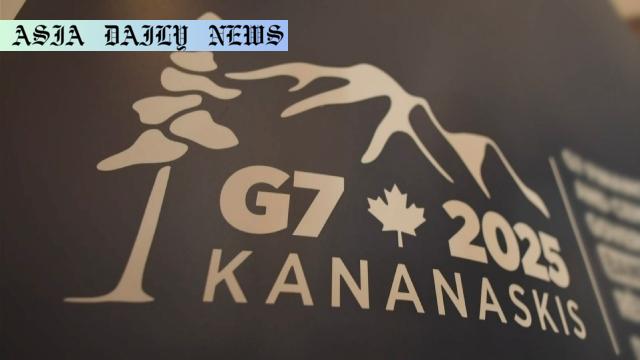America First agenda is expected to dominate Trump’s participation at the G7 summit in Canada, focusing on trade and energy export goals.

Trump’s ‘America First’ Agenda at the G7 Summit
The Group of Seven (G7) summit, hosted in Kananaskis, Canada, has become a focal point for discussions on global unity, economic cooperation, and geopolitical strategy. All eyes are on U.S. President Donald Trump as he continues to champion his ‘America First’ agenda. This theme, which has defined much of his presidency, will heavily influence his participation at this year’s summit. Trump’s central focus lies in seeking trade equity with other nations, effectively striving to ensure that America receives reciprocal treatment in its trade relationships. This approach has sparked intense global discourse, especially as the President has recently announced extensive tariffs that have left other nations scrambling to adjust their economic interactions with the U.S.
Trade Fairness and Economic Pursuits
Trump’s determination to reestablish fair trade as a priority has led him to address longstanding trade imbalances. At the summit, he is expected to call on G7 countries to reduce their trade surpluses with the United States. His administration views the U.S. trade deficit as a significant disadvantage that hampers the country’s economic prosperity. Trump’s strategy includes emphasizing the importance of reciprocal trade deals that benefit both parties fairly. Unsurprisingly, these pursuits have continually triggered friction among trade-dependent nations such as Germany, Canada, and Japan, who may perceive the U.S. tariffs as threatening regional economic stability.
Promoting Energy and AI Dominance
Beyond trade, Trump is taking a forward-thinking approach to enhance America’s energy exports and establish the nation as a global leader in Artificial Intelligence (AI). The Administration’s push to expand energy production will resonate at the summit as fossil fuel exporters contribute significant shares to U.S. economic growth. Meanwhile, AI—a transformative technology set to shape global industries—is another sector the U.S. seeks to dominate. Trump’s advocacy for these industries underscores his belief that national security and economic health are inherently interlinked. This strong stance on energy production and tech innovation solidifies his ‘America First’ directive for future economic competitiveness.
Shifting Dynamics within the G7
The decision by Canada, as this year’s G7 chair, to forego a joint communique reflects previous tensions among world leaders under Trump’s administration. Historically, Trump’s assertive stances on trade and national interest have led to disagreements with other G7 members. While unity and cooperation are central tenets of the summit, divergent views on trade policy and environmental issues continue to shape deeper rifts. The absence of a unified communique highlights lingering uncertainty about the degree of consensus G7 members can realistically achieve in addressing shared concerns.
The Path Forward
As President Trump attends the G7 summit, his firm commitment to the ‘America First’ philosophy embodies the evolving nature of economic diplomacy. His advocacy for trade fairness, energy dominance, and leadership in emerging technologies signals that the U.S. is focused on protecting its interests first. While this vision poses significant challenges to global partnerships, it equally offers a pathway for renegotiating crucial trade agreements. It remains imperative for all G7 members to foster mutual understanding and balance national agendas to achieve sustainable and equitable growth across the global economy.
Commentary
Analyzing Trump’s ‘America First’ Strategy
President Trump’s ‘America First’ agenda has consistently made headlines for its emphasis on reshaping global trade. By advocating for reciprocal and fair trade deals, Trump has sought to address U.S. concerns over the growing trade deficit. While this may resonate well within domestic circles, it is evident that this stance has caused tensions with traditional allies. The G7 summit provides an influential platform to examine whether the pursuit of this agenda can balance national interests with global cooperation. The discussions are likely to trigger a re-evaluation of longstanding trade policies, though it remains unclear whether such changes will align with the summit’s broader goals of unity and shared growth.
Impact on Energy and Technological Innovation
One of the more intriguing aspects of Trump’s agenda is his focus on energy exports and AI leadership. Energy exports, particularly in oil and gas, have become a major revenue stream for the U.S. economy, enabling stronger leverage in international markets. Additionally, establishing leadership in Artificial Intelligence holds long-term implications for economic growth and global dominance. The emphasis on these sectors signifies Trump’s broader strategy of maintaining America’s competitive edge in areas that will define the 21st century. However, the success of these initiatives depends as much on international cooperation as on domestic advancements, posing inherent challenges to achieving these ambitious objectives.
The Role of the G7 Summit Moving Forward
The absence of a joint communique at this year’s G7 summit underlines the shifting dynamics of international cooperation. Leaders within the G7 must now consider how to accommodate differing national priorities without undermining the collective vision of the summit. For Trump, the challenge lies in advancing ‘America First’ goals without alienating allies or exacerbating economic tensions. Ultimately, the path forward will require a mix of strategic negotiation and an openness to compromise. As the world continues to grapple with pressing economic and security issues, the role of the G7 summit in fostering diplomatic consensus remains vital.


